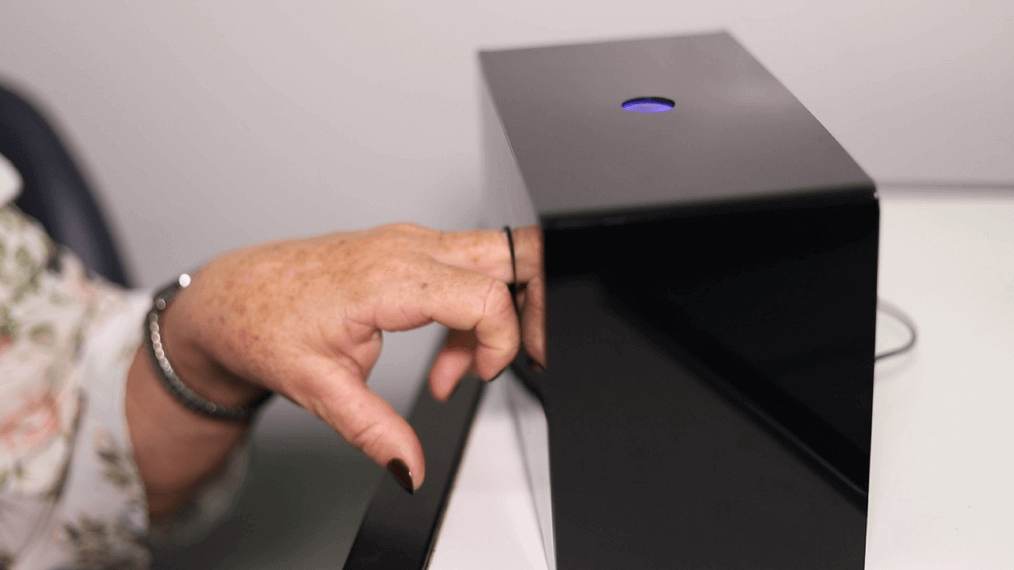By Valéria Credidio – Ascom LAIS
More than 20 million people in Brazil suffer from osteoporosis, a disease that is characterized by the progressive loss of bone mass, making bones weakened and predisposed to fractures. Most patients are women over 50 years old. Early diagnosis can prevent the acceleration of this bone loss that can progress to fractures and even the patient’s death. The diagnosis can be made through a bone densitometry exam which, due to its high cost, is not available to all patients who need it.
In Messias Targino, a municipality with just over four thousand inhabitants, in the interior of Rio Grande do Norte, it has an alternative for the diagnosis of its residents, who seek the Basic Health Unit. Using a small device, with new technology and receiving the results instantly, local doctors can diagnose any bone alteration and make the necessary referrals. This agility is due to the Osseus project.
Osseus is the result of applied research carried out in the doctoral thesis of LAIS researcher Agnaldo Souza Cruz, from the Laboratory of Technological Innovation in Health (LAIS/UFRN). With new technology, simpler, faster, cheaper and essential for tracking the population at risk for osteoporosis, the project allows the initial screening and selection of patients who need an additional evaluation with densitometry. The entire diagnosis can be carried out using a small, easy-to-carry device that, instead of emitting radiation, uses electromagnetic microwaves.
Some of the results obtained by the project are already known to the scientific community, through the publication of the article A method based on nonionizing microwave radiation for ancillary diagnosis of osteoporosis: a pilot study, published in BioMedical Engineering OnLine. “The recently published pilot study validated the device, showing that it can differentiate bone structures with different densities, characterizing their microarchitecture”, explained the research physician and one of the authors of the article, Josivan Gomes de Lima.
With an easy-to-operate, low-cost portable device, the equipment provides scalability and enhances its use anywhere in Brazil. The test performed is not invasive and can be applied in shorter time intervals, as there are no side effects for patients, unlike other traditional methods. Osseus was validated by LAIS researchers in partnership with researchers from MIT, Massachusetts Institute of Technology, in the city of Cambridge – MA/USA.
The technology used is simple. The device was developed with an array of antennas, techniques for extracting patient characteristics and pattern recognition using artificial intelligence to screen patients with osteoporosis. “With more devices available to measure bone mineral density, it will be possible to diagnose osteoporosis early, reduce costs with hospitalization, exams, surgeries and prostheses” explained the researcher at the Advanced Center for Technological Innovation (NAVI/IFRN), Gabriela Albuquerque.
Social equity
Much more than providing advances in the diagnosis of osteoporosis and facilitating the prevention of more serious problems, the Osseus project is of great importance in the conduct of public policies, with the incorporation of technology in primary care. According to Agnaldo Cruz, as it is easy to handle, the equipment has the potential to be implemented in all Brazilian municipalities, without technological difficulties. “Due to its easy handling, it can be present in any basic health unit, enabling the reduction of fractures and costs with their treatment. Osseus’ main objective is to promote quality of life for the Brazilian population, in the face of this silent disease”, he argued.
For Ricardo Valentim, executive director of LAIS, Osseus will qualify the diagnosis, with regard to bone densitometry, identify problems early and increase access to health services, expanding and qualifying the regulatory process. “Only those patients who really need it will go to high complexity, reducing the waiting lists for exams. It improves diagnosis in primary care and, above all, equity in health service care”, he concluded.





